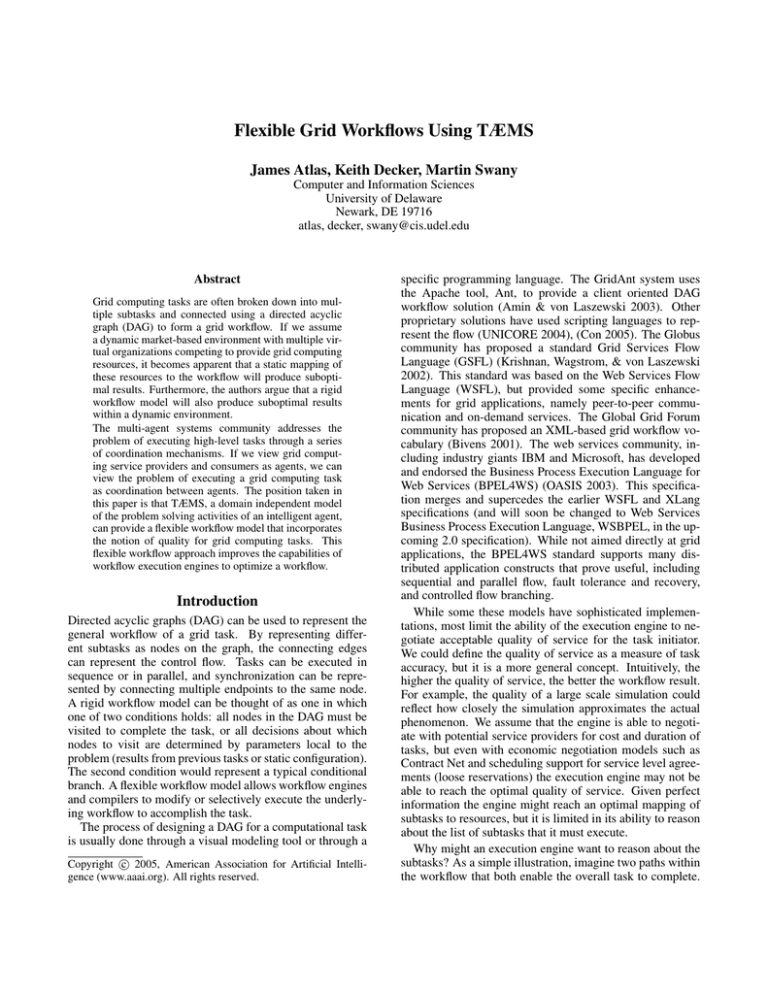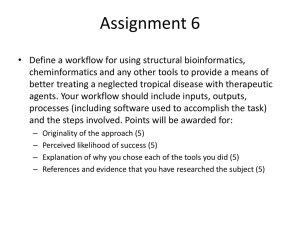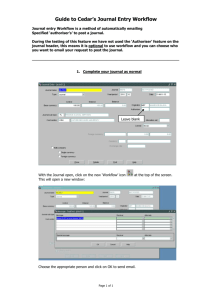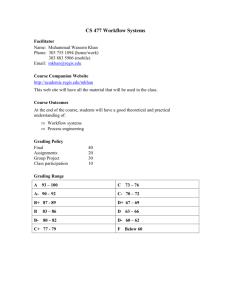
Flexible Grid Workflows Using TÆMS
James Atlas, Keith Decker, Martin Swany
Computer and Information Sciences
University of Delaware
Newark, DE 19716
atlas, decker, swany@cis.udel.edu
Abstract
Grid computing tasks are often broken down into multiple subtasks and connected using a directed acyclic
graph (DAG) to form a grid workflow. If we assume
a dynamic market-based environment with multiple virtual organizations competing to provide grid computing
resources, it becomes apparent that a static mapping of
these resources to the workflow will produce suboptimal results. Furthermore, the authors argue that a rigid
workflow model will also produce suboptimal results
within a dynamic environment.
The multi-agent systems community addresses the
problem of executing high-level tasks through a series
of coordination mechanisms. If we view grid computing service providers and consumers as agents, we can
view the problem of executing a grid computing task
as coordination between agents. The position taken in
this paper is that TÆMS, a domain independent model
of the problem solving activities of an intelligent agent,
can provide a flexible workflow model that incorporates
the notion of quality for grid computing tasks. This
flexible workflow approach improves the capabilities of
workflow execution engines to optimize a workflow.
Introduction
Directed acyclic graphs (DAG) can be used to represent the
general workflow of a grid task. By representing different subtasks as nodes on the graph, the connecting edges
can represent the control flow. Tasks can be executed in
sequence or in parallel, and synchronization can be represented by connecting multiple endpoints to the same node.
A rigid workflow model can be thought of as one in which
one of two conditions holds: all nodes in the DAG must be
visited to complete the task, or all decisions about which
nodes to visit are determined by parameters local to the
problem (results from previous tasks or static configuration).
The second condition would represent a typical conditional
branch. A flexible workflow model allows workflow engines
and compilers to modify or selectively execute the underlying workflow to accomplish the task.
The process of designing a DAG for a computational task
is usually done through a visual modeling tool or through a
c 2005, American Association for Artificial IntelliCopyright gence (www.aaai.org). All rights reserved.
specific programming language. The GridAnt system uses
the Apache tool, Ant, to provide a client oriented DAG
workflow solution (Amin & von Laszewski 2003). Other
proprietary solutions have used scripting languages to represent the flow (UNICORE 2004), (Con 2005). The Globus
community has proposed a standard Grid Services Flow
Language (GSFL) (Krishnan, Wagstrom, & von Laszewski
2002). This standard was based on the Web Services Flow
Language (WSFL), but provided some specific enhancements for grid applications, namely peer-to-peer communication and on-demand services. The Global Grid Forum
community has proposed an XML-based grid workflow vocabulary (Bivens 2001). The web services community, including industry giants IBM and Microsoft, has developed
and endorsed the Business Process Execution Language for
Web Services (BPEL4WS) (OASIS 2003). This specification merges and supercedes the earlier WSFL and XLang
specifications (and will soon be changed to Web Services
Business Process Execution Language, WSBPEL, in the upcoming 2.0 specification). While not aimed directly at grid
applications, the BPEL4WS standard supports many distributed application constructs that prove useful, including
sequential and parallel flow, fault tolerance and recovery,
and controlled flow branching.
While some these models have sophisticated implementations, most limit the ability of the execution engine to negotiate acceptable quality of service for the task initiator.
We could define the quality of service as a measure of task
accuracy, but it is a more general concept. Intuitively, the
higher the quality of service, the better the workflow result.
For example, the quality of a large scale simulation could
reflect how closely the simulation approximates the actual
phenomenon. We assume that the engine is able to negotiate with potential service providers for cost and duration of
tasks, but even with economic negotiation models such as
Contract Net and scheduling support for service level agreements (loose reservations) the execution engine may not be
able to reach the optimal quality of service. Given perfect
information the engine might reach an optimal mapping of
subtasks to resources, but it is limited in its ability to reason
about the list of subtasks that it must execute.
Why might an execution engine want to reason about the
subtasks? As a simple illustration, imagine two paths within
the workflow that both enable the overall task to complete.
<process>
<join>
<invoke> Algorithm A
<flow>
<invoke> Algorithm B
success
[A or B]
[else]
failure
Figure 1: BPEL4WS representation of the classic OR
Each path represents a different algorithm, but each obtain
the same results for a data set. Algorithm A uses twice as
many CPU cycles as algorithm B, and algorithm B uses
twice as much memory as algorithm A. The execution engine gains nothing by executing both paths, but must execute
at least one to finish the overall task. This could be represented as a classic OR condition in the workflow. BPEL4WS
is the only current workflow model that can handle this simple condition, as shown in Figure 1.
We can extend the idea of the classic OR to a non-boolean
OR in which we consider the quality of service. In the classic sense, success quality could map to a value of 1 and failure quality to 0. By extension, the range of values between
0 and 1 would represent varying levels of quality. For example, suppose the previous algorithm A produced a quality of
0.2 and algorithm B produced a quality of 0.5. If both algorithms were executed, the non-boolean OR would obtain the
resulting quality of 0.5. If only algorithm A was executed
the non-boolean OR would obtain the resulting quality of
0.2. If the workflow engine needed to produce a quality of
0.1 then it is free to choose algorithm A or B. If it needed a
quality of 0.4 then algorithm B is the only option.
Under current workflow languages, it is not possible to
represent this situation. BPEL4WS provides flexibility with
the classic OR case that enables the workflow engine to
selectively execute tasks. However, it does not provide a
representation of the task quality. Since the task quality is
determined by the designer of the workflow, this limits the
workflow engine’s ability to provide the best quality result.
Furthermore, there exist more complex task relationships
that affect quality than the simple non-boolean OR. Current
workflow languages do not enable workflow engines to handle these situations.
Approach
The problems discussed so far can be characterized by a lack
of expressiveness and flexibility in current workflow models.
One reason for this shortcoming is the domain from which
these flow languages evolved. The domain of business to
business (B2B) interactions has several properties that can
be seen in the design of the workflow languages. The first
property is runtime length. In most B2B transactions the
runtime is very short, often on the order of seconds. A short
runtime makes it disadvantageous to negotiate and re-plan
a workflow because of the computation time involved. The
second property is the rigidness of B2B structure itself. Predictable behavior is a tenet of financial and other mission-
critical applications. These properties are still present in certain grid applications, but we argue that in general they are
different. Grid computing emphasizes large scale tasks that
most likely have runtimes on the order of hours or longer.
It also has a notion of quality that is not present in typical B2B transactions. A quality level of 99% may be acceptable for a large graphics rendering application, whereas
most businesses would frown on a quality level of 99% for
a money transfer. These somewhat subtle differences in domains form the basis for a flexible workflow model.
In particular, a more robust model of task relationships
will be necessary to make the grid workflow flexible enough
to handle these situations. These task relationships have
been studied in great detail in the multi-agent systems community. Multi-agent systems often operate in a satisficing
mode in which the solution may not be 100% of the quality level, but instead meets some established minimum quality. In addition to the OR relationship explored earlier, other
task relationships have emerged that lack representation in
current workflow models. In the next section we propose
adopting the TÆMS model for these task relations, and explore how this could be implemented for a grid computing
task.
TÆMS models the task relations involved in problemsolving activities of intelligent agent systems (Horling et al.
1998). A task structure is represented as a graph that is hierarchically decomposed into subtasks. While allowing for
recursivity in the graph, for simplicity we will refer to this
task structure as a tree without much loss in expressiveness.
This tree contains sequences of subtasks, or sub-goals, and
methods. Methods represent leaf nodes of the tree that the
model has not decomposed (without loss of generality we
will refer to both subtasks and methods as tasks). TÆMS
differentiates between two types of node relationships: parent/child and node-to-node (peer-to-peer). The structure for
a parent/child connection is a quality accumulation function,
and for a node-to-node connection is an interrelationship.
The first structure for connections, Quality accumulation
functions (QAF), determines how the quality of child tasks
combine to produce the quality of the parent task. Many
functions have been developed for use within the model, but
we will focus on three of them. They are min, max, and sum.
From the TÆMS white-paper:
A min QAF is functionally equivalent to an AND
operator. The quality of the supertask is equal to the
minimum quality of its subtasks.
A max QAF is functionally equivalent to an OR operator. It says that the quality of the supertask is equal
to the maximum quality of any one of its subtasks.
The sum QAF says that the quality of the supertask is equal to the sum of the qualities of its subtasks,
regardless of order or which methods are actually invoked.
In our earlier example of the non-boolean OR, the two
paths could have been represented as child nodes to a parent
using the max QAF, as shown in Figure 2. The execution engine could then reason about which child node to execute to
produce the required quality at the parent node. A min QAF
Process
q_max
Algorithm A
quality = 0.2
Algorithm B
quality = 0.5
Figure 2: TÆMS representation of the non-boolean OR
could be used in execution when all subtasks must complete
for the supertask to produce any quality. It could be used to
represent a parallel computation on a segmented set of data
where any correct result must use the results of each segment
of data. A sum QAF could represent a large scale task where
each subtask produces a useful result and is aggregated with
others to produce the final result. This could be a graphics
scene rendering where the subtasks represent supersampled
points of light for a raytrace. The supertask quality is then
equal to the number of light points that have completed their
raytrace.
These are simple examples, but give us a starting place
to examine the benefits of the model. Suppose the raytracing application belongs to a commercial movie studio
that is paying for computing power using an on demand
market. Also assume that during the movie development
phase, the studio requires frequent full-length renderings to
gauge progress. The studio has allocated a certain amount
of money for the execution and the engine realizes during
processing that it will not be able to complete the task on
time and under budget. Under current workflow models the
engine has no real recourse (other than to perhaps terminate
the application or notify someone in charge of the shortcoming). Under a TÆMS model the studio could have told the
engine that tracing 90% of the rays is an acceptable quality level for the pre-release renderings (of course 100% is
preferred and would be required for the late stages and final release). Given this optimization function and the QAF
structure, the execution engine could have chosen to only
execute 90% of the subtasks and met the requested quality
level. If this 10% reduction in required computing power
allowed the application to finish on time and within budget,
the engine has accomplished the task that was impossible
under current workflow models.
The other TÆMS structure for connections, the node-tonode interrelationship structure, is represented by two types,
enables and facilitates (actually four if you include their
opposites, disables and hinders which we will not discuss
here). The enable relationship specifies an ordering between
two tasks. If task A is said to enable task B, then task A
must be performed before task B can accumulate any quality. This relationship provides for sequential task ordering
essential to current workflow models. The facilitates type
specifies a beneficial effect of performing a task. If task A
is said to facilitate task B, then by executing task A, task B
may have a shorter runtime, lower cost, or increased quality.
The facilitates relationship is not present in current workflow models, but again can improve the reasoning capabilities of the execution engine. For example, an algorithm C
can run using any random data set, but produces a higher
quality result when algorithm D has preprocessed the data.
Using TÆMS, algorithm D facilitates algorithm C, and the
workflow engine could decide to execute algorithm D if the
increased quality was worth the cost. In current workflow
models the boolean evaluation of success means that the
workflow engine cannot distinguish between the results of
executing D then C or just executing C.
Conclusion
We have explored the idea of a flexible workflow model using the notion of quality of service within grid applications.
Through the use of several examples it has been shown that a
flexible model offers several advantages over the rigid models present in current workflow languages. In particular,
the task relationships in the TÆMS language have been applied to these examples to show that these advantages translate into improvements for grid workflow execution engines.
The next logical step would be to extend a currently accepted
grid workflow standard with TÆMS structures, or to propose a new model that reflects a combination of both. This
model could then be integrated with an advanced workflow
execution module and experimental results could be gathered for performance measurements in an actual grid application. This future work would experimentally validate the
ideas presented here, and provide a richer understanding of
the advantages of flexible grid workflows.
References
Amin, K., and von Laszewski, G.
2003.
GridAnt: A Grid Workflow System. Website: http://wwwunix.globus.org/cog/projects/gridant/.
Bivens, H. P. 2001. Grid workflow. Grid Computing Environments Working Group, Category: Experimental.
Condor Team, University of Wisconsin-Madison, Website:
http://www.cs.wisc.edu/condor/manual/. 2005. Condor
Version 6.6.9 Manual.
Horling, B.; Lesser, V.; Vincent, R.; Wagner, T.;
Raja, A.; Zhang, S.; Decker, K.; and Garvey, A.
1998.
The taems white paper.
Available from
http://dis.cs.umass.edu/research/taems/white/.
Krishnan, S.; Wagstrom, P.; and von Laszewski, G. 2002.
Gsfl : A workflow framework for grid services. In Preprint
ANL/MCS-P980-0802.
OASIS.
2003.
Business process execution
language for web services.
Available from
http://www.ibm.com/developerworks/library/specification/wsbpel/.
UNICORE.
2004.
The unicore grid middleware. Available from the UNICORE Forum website:
http://www.unicore.org/.





